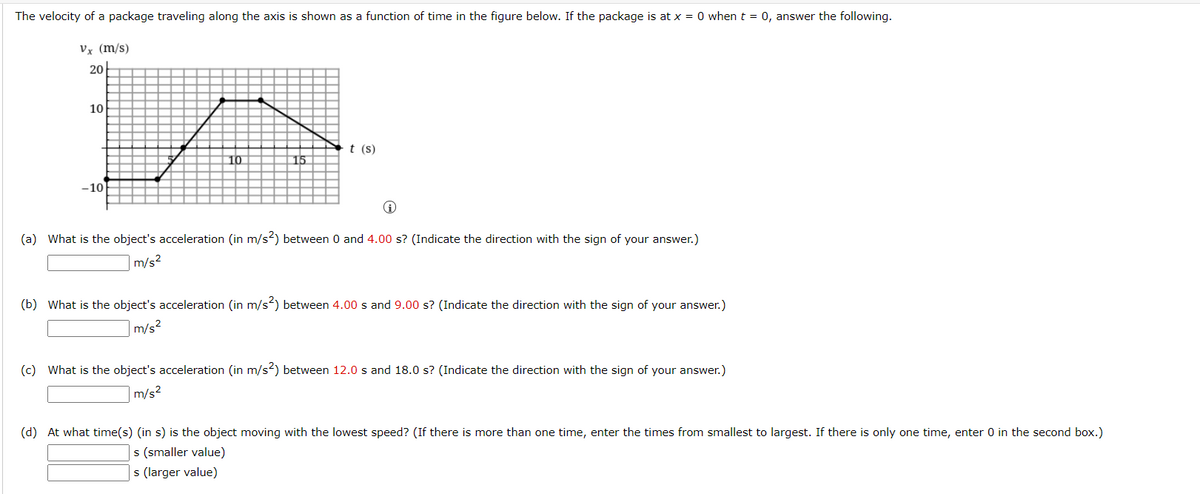The velocity of a package traveling along the axis is shown as a function of time in the figure below. If the package is at x = 0 when t = 0, answer the following. Vy (m/s) 20 10 t (s) -10 (a) What is the object's acceleration (in m/s?) between 0 and 4.00 s? (Indicate the direction with the sign of your answer.) m/s² (b) What is the object's acceleration (in m/s²) between 4.00 s and 9.00 s? (Indicate the direction with the sign of your answer.) m/s² (c) What is the object's acceleration (in m/s2) between 12.0 s and 18.0 s? (Indicate the direction with the sign of your answer.) ]m/s² (d) At what time(s) (in s) is the object moving with the lowest speed? (If there is more than one time, enter the times from smallest to largest. If there is only one time, enter 0 in the second box.) ] s (smaller value) | s (larger value)
The velocity of a package traveling along the axis is shown as a function of time in the figure below. If the package is at x = 0 when t = 0, answer the following. Vy (m/s) 20 10 t (s) -10 (a) What is the object's acceleration (in m/s?) between 0 and 4.00 s? (Indicate the direction with the sign of your answer.) m/s² (b) What is the object's acceleration (in m/s²) between 4.00 s and 9.00 s? (Indicate the direction with the sign of your answer.) m/s² (c) What is the object's acceleration (in m/s2) between 12.0 s and 18.0 s? (Indicate the direction with the sign of your answer.) ]m/s² (d) At what time(s) (in s) is the object moving with the lowest speed? (If there is more than one time, enter the times from smallest to largest. If there is only one time, enter 0 in the second box.) ] s (smaller value) | s (larger value)
University Physics Volume 1
18th Edition
ISBN:9781938168277
Author:William Moebs, Samuel J. Ling, Jeff Sanny
Publisher:William Moebs, Samuel J. Ling, Jeff Sanny
Chapter3: Motion Along A Straight Line
Section: Chapter Questions
Problem 9CQ: If you divide the total distance traveled on a car trip (as determined by the odometer) by the...
Related questions
Question

Transcribed Image Text:(e) At what time (in s) is the object farthest from x = 0?
(f) What is the final position x (in m) of the object at t = 18 s?
m
(g) Through what total distance (in m) has the object moved between t = 0 and t = 18 s?
%3D
m

Transcribed Image Text:The velocity of a package traveling along the axis is shown as a function of time in the figure below. If the package is at x = 0 when t = 0, answer the following.
Vx (m/s)
20
10
t (s)
10
15
-10
(a) What is the object's acceleration (in m/s2) between 0 and 4.00 s? (Indicate the direction with the sign of your answer.)
m/s?
(b) What is the object's acceleration (in m/s) between 4.00 s and 9.00 s? (Indicate the direction with the sign of your answer.)
m/s?
(c) What is the object's acceleration (in m/s²) between 12.0 s and 18.0 s? (Indicate the direction with the sign of your answer.)
m/s?
(d) At what time(s) (in s) is the object moving with the lowest speed? (If there is more than one time, enter the times from smallest to largest. If there is only one time, enter 0 in the second box.)
s (smaller value)
s (larger value)
Expert Solution
This question has been solved!
Explore an expertly crafted, step-by-step solution for a thorough understanding of key concepts.
This is a popular solution!
Trending now
This is a popular solution!
Step by step
Solved in 3 steps

Knowledge Booster
Learn more about
Need a deep-dive on the concept behind this application? Look no further. Learn more about this topic, physics and related others by exploring similar questions and additional content below.Recommended textbooks for you

University Physics Volume 1
Physics
ISBN:
9781938168277
Author:
William Moebs, Samuel J. Ling, Jeff Sanny
Publisher:
OpenStax - Rice University

University Physics Volume 1
Physics
ISBN:
9781938168277
Author:
William Moebs, Samuel J. Ling, Jeff Sanny
Publisher:
OpenStax - Rice University